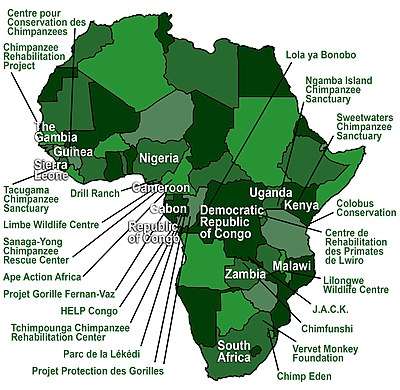Pan African Sanctuary Alliance
The Pan African Sanctuary Alliance (PASA) is the largest association of wildlife centers in Africa. The aim of PASA is to secure a future for Africa's primates and their habitat by rescuing and caring for orphaned apes and monkeys, promoting the conservation of wild primates, educating the public, empowering communities, and working to stop the illegal trade in wildlife.[1]
Founded in 2000 in Uganda, the Pan African Sanctuary Alliance currently consists of 23 member sanctuaries in 13 African countries and a network of advisors and supporters from around the world. PASA is a 501(c)(3) non-profit charity registered in the USA. PASA is a partner of the United Nations Environment Programme's Great Apes Survival Partnership and is a member of the Species Survival Network.
Rescue and care
Hundreds of apes and monkeys are rescued by PASA sanctuaries annually. On average, 57 chimpanzees arrived at PASA's member wildlife centers per year between 2000 and 2006. Of those animals, the majority were acquired through confiscation.[2]
PASA provides emergency support including funding and the technical assistance necessary to reach established standards of care and welfare for these primates confiscated from illegal trade practices. To do this, PASA provides training and skill-building workshops that bring together staff from member sanctuaries across Africa with other veterinary and medical experts from around the world. PASA distributes equipment, supplies, and medicine that enable wildlife centers to deliver expert healthcare and rehabilitation services for confiscated primates and other wildlife.[1]
Education and community empowerment
The Pan African Sanctuary Alliance provides funding, training, and materials to assist its wildlife centers in their conservation efforts within their communities. The centers facilitate projects that aim to promote sustainable incomes and include activities, like planting low impact crops that do not attract wildlife, creating native tree nurseries, raising livestock sustainable in the local environment to replace bushmeat hunting, and developing women's craft cooperatives that use local renewable or recycled materials to make crafts that can be sold to provide income.[1]
According to a study that involved the administration of surveys to each of the PASA member wildlife centers, "Sanctuaries reported that they provided employment for over 550 local community members across Africa, as well as resources for community education and infrastructure, with an economic impact over $3 million per year."[3]
Reintroduction and protection of wild populations
Organizations that are members of the Pan African Sanctuary Alliance are some of the only organizations to have achieved reintroduction of great ape species in the wild and are among the first to release chimpanzees and bonobos in the world.[3] Among the PASA wildlife centers, about half are working on reintroducing individuals to the wild.[4]
The Pan African Sanctuary Alliance works to oppose unsustainable logging and palm oil concessions, oil and gas development in national parks, and other threats to primate habitats. Nearly three-quarters of PASA sanctuaries conduct anti-poaching patrols in primate habitats.[1]
Wildlife centers

- Ape Action Africa (Cameroon)
- Centre pour Conservation des Chimpanzees (CCC) (Guinea)
- Chimfunshi Wildlife Orphanage (Zambia)
- Chimp Eden (South Africa)
- Chimpanzee Rehabilitation Project (Gambia)
- Colobus Conservation (Kenya)
- Drill Ranch (Nigeria)
- Fernan-Vaz Gorilla Project (Gabon)
- HELP-Congo (Congo)
- Jeunes Animaux Confisques au Katanga (J.A.C.K.) (Democratic Republic of the Congo) (DRC)
- Lilongwe Wildlife Centre (Malawi)
- Limbe Wildlife Centre (Cameroon)
- Lola ya Bonobo (DRC)
- Lwiro Primate Rehabilitation Centre (DRC)
- Ngamba Island (Chimpanzee Sanctuary and Wildlife Conservation Trust) (Uganda)
- Project Protection des Gorilles-Congo (Congo)
- Project Protection des Gorilles-Gabon (Gabon)
- Sanaga-Yong Chimpanzee Rescue Center (IDA Africa) (Cameroon)
- Sweetwaters Chimpanzee Sanctuary (Kenya)
- Tacugama Chimpanzee Sanctuary (Sierra Leone)
- Tchimpounga Chimpanzee Rehabilitation Centre (Congo)
- Vervet Monkey Foundation (South Africa)
References
- "Pan African Sanctuary Alliance". Pan African Sanctuary Alliance.
- Faust, Lisa J.; Cress, Doug; Farmer, Kay H.; Ross, Stephen R.; Beck, Benjamin B. (2011). "Predicting Capacity Demand on Sanctuaries for African Chimpanzees (Pan Troglodytes)". International Journal of Primatology. 32.4: 849–64. doi:10.1007/s10764-011-9505-z.
- Ferrie, Gina M.; Farmer, Kay H.; Kuhar, Chris W.; Grand, Alison P.; Sherman, Julie; Bettinger, Tammie L. "The Social, Economic, and Environmental Contributions of Pan African Sanctuary Alliance Primate Sanctuaries in Africa". Pan African Sanctuary Alliance. Info PASA.
- Beck, Benjamin; Walkup, Kristina; Rodrigues, Michelle; Unwin, Steve; Travis, Dominic; Stoinski, Tara (2007). "Best Practice Guidelines for the Re-introduction of Great Apes" (PDF). Occasional Paper of the IUCN Species Survival Commission. No. 35.